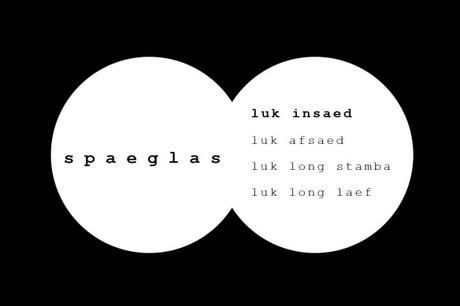 Contextualising COMA for Vanuatu: Part 3 (background here)
Contextualising COMA for Vanuatu: Part 3 (background here)
So, the college term is moving on and I’m continuing to struggle through teaching Interpreting the Bible. For the time being I’m running with the title ‘Spaeglas’ for what was once COMA. Spaeglas is the Bislama word for telescope or binoculars, and so is a metaphor for looking carefully at the text. The four points being:
Luk Insaed (Look Inside)
Luk Afsaed (Look Outside)
Luk long Stamba (Look for the Central Message)
Luk long Laef (Look to Life)
Here are the steps for Luk Insaed that I’m teaching at the moment for you to have a look at and maybe contribute to. It’s not a lesson plan – this would be taught over about three lessons with homework in between – it’s more the bare bones; things to work through in order to thoroughly observe a passage. It’s pretty rough and raw at the moment with little editing.
Compared to COMA – Observe, I have tried to make the steps more concrete and to use strategies that will work well for oral people, including some things I’ve picked up in the comments from previous posts – thank you so much.
Below the outline, I will add a couple of questions and areas that I can see need improvement and a little lesson illustration that you could help with (even if you don’t have Bislama). Below that, in the comments, you can fire away with your own input (please!).

1) Ridim gud pasej
Sam samting blong givhan:
1) Ridim plante taem (tri taem). Go slo slo.
2) Ridimaot hem. Trae blong ridim long gudfala fasin olsem wan man we i stap toktok.
3) Ridim long lanwis blong yu (sipos yu yu gat)
4) Lisin long hem. Yusum MegaVoice o mobael fon o askem wan man blong ridim long yu.
5) Raetem aot hem (sipos yu wan we yu save raet, fasin ya i givhan long yu bigwan).
2) Lukaotem ol impoten wod
Sam samting blong lukaotem
Sipos yu raetemaot pasej finis, makem long pepa blong yu, sipos no, raetem daon ol wod ya or tingbaot olgeta.
a) Eni impoten wod we i stap plante taem long pasej
Samtaem ol wod ya i soemaot bigfala tingting blong pasej.
e.g. long Mak 2:1-12 wod ya “sin” mo wod ya “tekemaot” i stap plante taem. Wan samting ya i soemaot se pasej ya i no rili tokbaot sik blong man, bigfala tingting hem i sin blong man.
b) Eni wod we i hevi mo hem i poen long ol bigfala tingting long Baebol.
Olsem: sin, mekem nogud, gladhat, gud nius, luv, tekemaot sin, loa, mekem stret, pemaot, fogivim, bilif, Pikinini blong God, Pikinini blong Man, God Papa, God Pikinini, God Tabu Spirit, king, Mesaea, Kraes, promes, niufala laef, wosip, presem, folem, biaen (sipos i tokbaot folem o biaen long Jisas)
e.g. Mak 2:2:1-12 i gat sam impoten wod olsem “bilif” (2:5), sin (2:5, 9) tekemaot / tekemaot sin (2:5, 7, 9, 10), tok nogud (2:7), God / presem God(2:7, 12), Pikinini blong Man (2:10).
c) Eni wod we yu no save mining blong hem
Sipos yu no save mining blong wan wod, i gud yu faenemaot mining blong hem. Hem ya sam rod blong faenemaot mining:
- Plante Baebol i gat diksonari i stap long en blong hem (sipos yu ridim Bislama Baebol, sta ya * i minim se wod ya i stap long diksonari).
- Askem wan pasta o wan nara man we maet hem i save.
- Sipos yu gat wan Baebol komentri maet yu jekem hem
Eg: Mark 2:6 i gat “tija blong Loa” mo maet yu no save se huia olgeta ya tija blong Loa. Bislama Baebol i gat * is stap long “Loa,” mekem se yu save go long diksonari long en mo ridim tok long saed blong Loa. Be sipos tok ya i no naf, yu save go long Vanuatu Baebol Komentri Mak Japta 1-5 mo go long pej 53 mo 212 we i givim moa tingting bakegen.
3) Tingbaot ol haf blong pasej
Taem yumi seraotem wan pasej i go long sam smol haf, hem i mekem se i no had tumas blong winim hem.
I no gat wan fasin blong seraotem pasej we i wok evri taem from we evri pasej i defren, be maet wan long ol samting ya i wok gud:
a) Lukaotem ol wod we oli kaen wok blong joenem ol haf, olsem: afta, biaen, naoia, taem, from we, taswe, tru long.
Samtaem ol kaen wod ya oli soemaot ol haf
e.g Kolosi 1:21-23 hem i yusum taem
1) v21 “Bifo…” – Yumi strenja long God
2) v22-23 “Be naoia…” Yumi fren long God
e.g. Seken Timoti 4:1-5
1) 1-2 Pol givim strong tok long Timoti (stamba tingting)
2) 3-4 “Yu mas mekem olsem, from we…” Fasin nogud
3) v5 “Oltaem…yu…” Fasin blong folem
b) Sipos pasej i gat eksampol blong sam defren man, o tok long saed blong defren man, maet yu yusum ol man ya blong fomemap ol haf
e.g. Matiu 7:24-27
1) 24-25 Man we i waes
2) 26-27 Man we i no waes
e.g. Efesas 2:1-7
1) 1-3 Yumi evriwan
2) 4-7 God
c) Sipos pasej i gat sam defren samting we oli hapen, maet ol samting ya i fomemap ol haf.
e.g. Jajes 3:7-11
1) v7 Ol man oli mekem nogud
2) v8 God i kros long ol man
3) v9 Ol man oli krae long God
4) v9b-11 God i sevem ol man blong hem
e.g. Luke 8:22-25
1) 22-24 Merikel blong Jisas
2) 25 Tu ansa / Merikel i soemaot huia Jisas
d) Sipos man we i raetem hem i yusum sam defren poen or hem i givim sam defren risen blong wan samting, yusum ol poen ya.
e.g. Jemes 2:1-13
1) 1-4 Fasin we yumi no mas mekem (stamba tingting)
2) 5-7 Risen 1: Yumi mas luk wetem ae blong God
3) 8-13 Risen 2: fasin ya i agensem loa blong God
e.g. Ol Sam 98
1) 1-3 Presem God from we hem i sevem man
2) 4-6 Presem God from we hem i king
3) 7-9 Presem God from we hem i jaj
e) Maet pasej i gat fasin we i gud mo fasin we i no gud.
e.g. Kolosi 3:5-14
1) 5-11 Olfala laef we yumi mas sakem
2) 12-14 Niufala laef we yumi mas putum
e.g. Jemes 3:13-18 – Tu Kaen Waes
1) Stamba tingting v13
2) Waes blong wol v14-16
3) Waes blong heven v17-18
e.g. Matiu 6:5-13
1) v5, 7-8 Fasin blong prea we i no stret
2) v6, 9-13 Fasin blong prea we i stret
4) Talemaot hem bakegen long on toktok blong yu
Yu no traem blong talemaot mining blong hem long ples ya, nogat.
Jas talemaot evri samting we i stap, olsem we yu talem hem long wan fren blong yu. Trae blong rimemba evri samting we i stap long pasej.
Afta yu mekem, ridim bakegen, blong yu yu jekem yu, o askem wan narafala blong jekem yu.
Sam mistek blong lukaotem
- Maet yumi no luk ol samting we i stap from we yumi les o from we yumi ting se yumi save pasej finis.
- Maet yumi ronwe long ol had samting from we yumi fraet long hem, be maet ol had samting ya i soemaot mining.
- Maet yumi no lukluk gud long ol smol smol wod (olsem ol wod we oli joenem ol smolsmol haf)
- Maet yumi putum on tingting blong yumi insaed long pasej. Yumi mas ridim ol samting we i stap nomo.
Ok, I few queries:
- Would you add any overall points? Have I missed anything big that you have found that helps people to grasp what a passage is actually saying?
- Can you think of any other ways that passages tend to break into bite-sized chunks?
- Can you think of any more examples of passages that I could use? I don’t think Colossians 3:5-14 was a particularly good example of what it was meant to illustrate because the divisions are a bit mixed. Jemes 2:1-13 is a bit hard to grasp quickly I think. The more examples the better because they can be used for practice.
- If you want to correct my spelling, grammar, etc. I would welcome it.

Now here’s a lesson thing I need help with.
I have been introducing the idea of observing the text carefully using a page from Graeme Base’s book, The Water Hole. The point is simply that when you first look you see only some things, but when you really look carefully, there’s a lot more to see. A Bible passage is the same.
The illustration is working really well. The problem is that I would like to share my lessons with others around the country and not everyone would have a copy of the book. It would be better to have a simpler illustration that could be photocopied and distributed. Any ideas?
